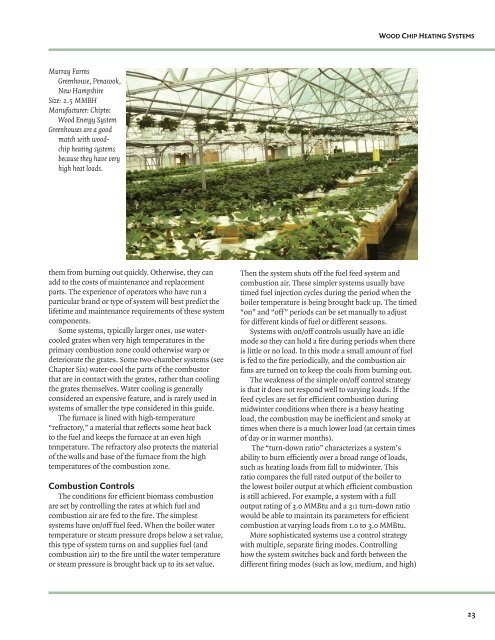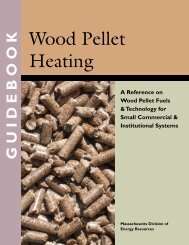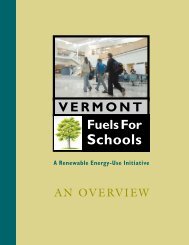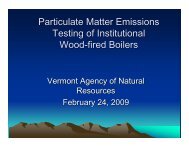Wood-Chip Heating Systems - Biomass Energy Resource Center
Wood-Chip Heating Systems - Biomass Energy Resource Center
Wood-Chip Heating Systems - Biomass Energy Resource Center
You also want an ePaper? Increase the reach of your titles
YUMPU automatically turns print PDFs into web optimized ePapers that Google loves.
Murray Farms<br />
Greenhouse, Penacook,<br />
New Hampshire<br />
Size: 2.5 MMBH<br />
Manufacturer: <strong>Chip</strong>tec<br />
<strong>Wood</strong> <strong>Energy</strong> System<br />
Greenhouses are a good<br />
match with woodchip<br />
heating systems<br />
because they have very<br />
high heat loads.<br />
them from burning out quickly. Otherwise, they can<br />
add to the costs of maintenance and replacement<br />
parts. The experience of operators who have run a<br />
particular brand or type of system will best predict the<br />
lifetime and maintenance requirements of these system<br />
components.<br />
Some systems, typically larger ones, use watercooled<br />
grates when very high temperatures in the<br />
primary combustion zone could otherwise warp or<br />
deteriorate the grates. Some two-chamber systems (see<br />
Chapter Six) water-cool the parts of the combustor<br />
that are in contact with the grates, rather than cooling<br />
the grates themselves. Water cooling is generally<br />
considered an expensive feature, and is rarely used in<br />
systems of smaller the type considered in this guide.<br />
The furnace is lined with high-temperature<br />
“refractory,” a material that refl ects some heat back<br />
to the fuel and keeps the furnace at an even high<br />
temperature. The refractory also protects the material<br />
of the walls and base of the furnace from the high<br />
temperatures of the combustion zone.<br />
Combustion Controls<br />
The conditions for effi cient biomass combustion<br />
are set by controlling the rates at which fuel and<br />
combustion air are fed to the fi re. The simplest<br />
systems have on/off fuel feed. When the boiler water<br />
temperature or steam pressure drops below a set value,<br />
this type of system turns on and supplies fuel (and<br />
combustion air) to the fi re until the water temperature<br />
or steam pressure is brought back up to its set value.<br />
Then the system shuts off the fuel feed system and<br />
combustion air. These simpler systems usually have<br />
timed fuel injection cycles during the period when the<br />
boiler temperature is being brought back up. The timed<br />
“on” and “off ” periods can be set manually to adjust<br />
for different kinds of fuel or different seasons.<br />
<strong>Systems</strong> with on/off controls usually have an idle<br />
mode so they can hold a fi re during periods when there<br />
is little or no load. In this mode a small amount of fuel<br />
is fed to the fi re periodically, and the combustion air<br />
fans are turned on to keep the coals from burning out.<br />
The weakness of the simple on/off control strategy<br />
is that it does not respond well to varying loads. If the<br />
feed cycles are set for effi cient combustion during<br />
midwinter conditions when there is a heavy heating<br />
load, the combustion may be ineffi cient and smoky at<br />
times when there is a much lower load (at certain times<br />
of day or in warmer months).<br />
The “turn-down ratio” characterizes a system’s<br />
ability to burn effi ciently over a broad range of loads,<br />
such as heating loads from fall to midwinter. This<br />
ratio compares the full rated output of the boiler to<br />
the lowest boiler output at which effi cient combustion<br />
is still achieved. For example, a system with a full<br />
output rating of 3.0 MMBtu and a 3:1 turn-down ratio<br />
would be able to maintain its parameters for effi cient<br />
combustion at varying loads from 1.0 to 3.0 MMBtu.<br />
More sophisticated systems use a control strategy<br />
with multiple, separate fi ring modes. Controlling<br />
how the system switches back and forth between the<br />
different fi ring modes (such as low, medium, and high)<br />
WOOD CHIP HEATING SYSTEMS<br />
23





